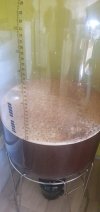Har lest litt om dette tidligere men aldri prøvd. Har blitt aktuelt da jeg muligens får tak i et egnet fat for gjæring av dobbel batch. Det er fristende å prøve dette med lager da det legges så mye tid og arbeid i kontrollert gjæring og lagring. Dessuten at man kan slippe unna med å gjære et dobbelt brygg med gjærstarteren til et enkelt gjør det for meg mulig å brygge dobbelt så mye øl som jeg har kapasitet til å lage starter til.
Er det noen som har prøvd dette? Det ser jo veldig tilforlatelig ut. Det største problemet blir vel å faktisk få til å brygge to dager på rad!
Definisjonen under er hentet fra Braukaiser.com (Kai Troester):
Drauflassen (German for letting something flow onto) is a common practice in large and small breweries. Especially when the fermenter capacity greatly exceeds the brew house capacity or when fresh yeast is introduced into the brewery. It allows pitching at a proper pitching rate with a reduced amount of yeast. Cooled and aerated wort is added to fill only 1/3 – ½ of the fermenter capacity. Then the yeast is pitched. After 24 hrs, when first signs of fermentation are visible and the first batch is at low Kraeusen the 2nd batch, which has been fully aerated, is added. Hence this technique is known as Double Batch in American brewing. Depending on how small the initial batch was, this process can be repeated a number of times. Narziss reports that this technique is beneficial to the attenuation and the ester levels of the final beer. The latter are reduced because the yeast is kept longer in its growth phase during which it consumes the ester precursor acetyl CoA [Narziss, 2005]
Er det noen som har prøvd dette? Det ser jo veldig tilforlatelig ut. Det største problemet blir vel å faktisk få til å brygge to dager på rad!
Definisjonen under er hentet fra Braukaiser.com (Kai Troester):
Drauflassen (German for letting something flow onto) is a common practice in large and small breweries. Especially when the fermenter capacity greatly exceeds the brew house capacity or when fresh yeast is introduced into the brewery. It allows pitching at a proper pitching rate with a reduced amount of yeast. Cooled and aerated wort is added to fill only 1/3 – ½ of the fermenter capacity. Then the yeast is pitched. After 24 hrs, when first signs of fermentation are visible and the first batch is at low Kraeusen the 2nd batch, which has been fully aerated, is added. Hence this technique is known as Double Batch in American brewing. Depending on how small the initial batch was, this process can be repeated a number of times. Narziss reports that this technique is beneficial to the attenuation and the ester levels of the final beer. The latter are reduced because the yeast is kept longer in its growth phase during which it consumes the ester precursor acetyl CoA [Narziss, 2005]


